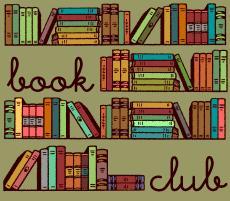 About this time each year, I share the books my book club read over the previous 12 months. If you’re looking for books to read, you might find a few in this list.
About this time each year, I share the books my book club read over the previous 12 months. If you’re looking for books to read, you might find a few in this list.
- The Last Hurrah by Edwin O’Connor. This 1956 account of big-city politics, inspired by the career of longtime Boston Mayor James M. Curley, portrays its Irish-American political boss as a demagogue and a rogue who nonetheless deeply understands his constituents. The book was later made into a John Ford film starring Spencer Tracy.
- A Constellation of Vital Phenomena by Anthony Marra. This story, set in Chechnya, demonstrates the transcendent power of love in wartime. It brings together the lives of 8-year-old Havaa, whose father is abducted in the middle of the night by Russian soldiers; her family’s neighbor, Akhmed , who takes responsibility for her; and Sonja Rabina, a doctor at the hospital at which Havaa and Akhmed seek refuge.
- The Childhood of Jesus by J.M. Coetzee. Not that Jesus! But David, the boy in this book, is certainly precocious and unique. This is an allegorical tale, and you’ll probably find yourself puzzled through most of the book. It provoked one of our most lively discussions. My personal favorite read this year.
- Between Man and Beast by Monte Reel. In 1856, Paul Du Chaillu ventured into the African jungle in search of a mythic beast, the gorilla. After wild encounters with vicious cannibals, deadly snakes, and tribal kings, Du Chaillu emerged with 20 preserved gorilla skins—two of which were stuffed and brought on tour—and walked smack dab into the biggest scientific debate of the time: Darwin’s theory of evolution. The book has a number of walk-on characters, from Abraham Lincoln to P.T. Barnum. Du Chaillu’s story is definitely worthy of your time.
- Hunting Eichmann by Neal Bascomb. You know he was captured, tried and executed. Now you’ll learn the details of how a small band of Holocaust survivors and Israel’s spy agency, Mossad, tracked him to Argentina, captured him and smuggled him out of the country and back to Israel for trial. It’s a real-life spy story that will keep you on the edge of your seat.
- Polio: An American Story by David M. Oshinsky. As a child in the 1950s, I saw my parents rejoice over the discovery of the Salk vaccine, and I remember being hustled to the doctor as quickly as possible to be saved from the scourge of polio. This book is a fascinating study of the rivalry between Jonas Salk and Albert Sabin; the role in leading the war on polio played by luminaries ranging from Franklin Roosevelt to Eddie Cantor; and the development of the nation’s first, disease-based PR juggernaut, the March of Dimes.
- Cannery Row by John Steinbeck, who draws on his memories of the real inhabitants of Monterrey, California, and interweaves their stories in this world where only the fittest survive—creating what is at once one of his most humorous and poignant works. A pleasure to read.
- A Widow for One Year by John Irving. The first third of Irving’s ninth novel tells the story of Eddie O’Hare, a prep school student with literary aspirations who lands a job as a personal assistant to noted children’s author Ted Cole in the summer of 1958. O’Hare spends most of the time in bed with Cole’s wife, Marion, who finds it impossible to shake the grief caused by the death of her sons in an auto accident. The second and third parts of the book describe O’Hare’s acquaintance, decades later, with Ruth Cole, Ted’s daughter, who is also a successful writer. While researching her latest novel, Ruth witnesses the murder of an Amsterdam window prostitute. The evening we discussed the book, we also watched the movie, The Door in the Floor, based on the first third of A Widow for One Year.
- Heart Earth by Ivan Doig. In this prize-winning prequel to his acclaimed memoir This House of Sky, Doig brings to life his childhood before his mother’s death and the family’s journey from the Montana mountains to the Arizona desert and back again. He eloquently captures the texture of the American West during and after World War II, the fortune of a family, and one woman’s indomitable spirit.
- The Children Act by Ian McEwan. Fiona Maye is a leading High Court judge who presides over cases in the family court. She is renowned for her fierce intelligence, exactitude, and sensitivity. But her professional success belies private sorrow and domestic strife. Her marriage of thirty years is in crisis. She is called on to try an urgent case: Adam, 17, is refusing for religious reasons the medical treatment that could save his life, and his devout parents echo his wishes. Time is running out. Should the secular court overrule sincerely expressed faith? In the course of reaching a decision, Fiona visits Adam in the hospital—an encounter that stirs long-buried feelings in her and powerful new emotions in the boy. Her judgment has consequences for them both.
- Undiluted Hocus-Pocus: The Autobiography of Martin Gardner by Martin Gardner. This unusual, accomplished gentleman wrote the Mathematical Games column for Scientific American for 25 years and published more than 70 books on topics as diverse as magic, philosophy, religion, pseudoscience, and Alice in Wonderland. His illuminating autobiography is a candid self-portrait of the man evolutionary theorist Stephen Jay Gould called our “single brightest beacon” for the defense of rationality and good science against mysticism and anti-intellectualism.
So that’s it for 2014. Let me know what you’ve been reading and what’s on your list for next year.

